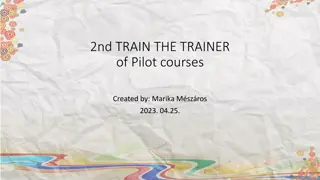
Plastic Waste Issue: Addressing Common Questions and Concerns
Explore answers to common questions on plastic waste issues such as calculations of plastic waste entering the ocean, methods to measure microplastics, and concerns about consuming fish contaminated with microplastics. Understand the current research findings and potential impacts on human health.
Download Presentation

Please find below an Image/Link to download the presentation.
The content on the website is provided AS IS for your information and personal use only. It may not be sold, licensed, or shared on other websites without obtaining consent from the author. If you encounter any issues during the download, it is possible that the publisher has removed the file from their server.
You are allowed to download the files provided on this website for personal or commercial use, subject to the condition that they are used lawfully. All files are the property of their respective owners.
The content on the website is provided AS IS for your information and personal use only. It may not be sold, licensed, or shared on other websites without obtaining consent from the author.
E N D
Presentation Transcript
How to answer the question To the Participants of Train the Trainer Many questions will arise about the plastic waste problem. How to answer those questions is a big issue for the lecturer. We suggest example answers and information to typical and simple questions. Some questions are tough to answer. Some questions may have different answers depending on the country and the times etc. But through these slides, please take the opportunity to ponder how to answer questions from students. In addition, it is also recommended that the instructor ask the students such questions. 1
How did researchers calculate the amount of plastic waste that inputs from land into the ocean? There are several estimates on the amount of plastic entering the ocean. Here we present the calculation way used in the most frequently cited papers. Amount of plastic waste entering into the ocean = Population living within 50km of the coast Amount of waste generated per capita (from GDP and other sources) Ratio of Mismanaged Waste Ratio of plastics in waste (estimated from information by country) Ratio discharged into the ocean (constant) Target Country: 192 Mismanaged Waste : Total of inadequately managed waste estimated by country and 2% littering It was calculated that 4.8 to 12.7 million MT entering the ocean in 2010. 8 million tons in the middle of that amount is a often used number. This is one estimate. There are various other estimates. 2 Source: Jambeck et al., 2015, Plastic waste inputs from land into the ocean, Science 13 Feb 2015 Vol 347, Issue 6223 pp. 768-771
How to measure microplastics floating in the ocean? Generally, microplastics are collected using special nets such as Neuston net and Manta net. (Originally, it is a net for collecting plankton in the sea) The net is towed by a ship. A typical mesh is about 300 m(0.3mm). If the mesh is too small, it will clog. Neuston net Manta net Microplastics can be collected by such fine mesh nets. Standardization of microplastic collection methods is underway. 3 Michida et al., 2019, Guidelines for Harmonizing Ocean Surface Microplastic Monitoring Methods, Ministry of the Environment, Japan
Should I not eat fish anymore because of the effects of microplastics? At this time, the intake of MP into the human body and its harmful effects are not at a problematic level. Even if you avoid eating fish, MP is easily taken in from other sources. Most of the bad effects of microplastics ingested by living organisms have been confirmed in the laboratory environment (=MP concentration is high). In the future, if the amount of plastic waste increases further, it may have an impact. However, there are long-term concerns such as the effects of additives and harmful substances attached to MP on the human body, so further research is expected. NHM Nor et al., 2021, Lifetime Accumulation of Microplastic in Children and Adults, Environ. Sci. Technol. 2021, 55, 8, 5084 5096 Barboza et al., 2020, Microplastics in wild fish from North East Atlantic Ocean and its potential for causing neurotoxic effects, lipid oxidative damage, and human health risks associated with ingestion exposure, Science of The Total Environment, Volume 717, 15 May 4 MSL Yee, 2021, Impact of Microplastics and Nanoplastics on Human Health, Nanomaterials 2021, 11(2), 496
Would replacing all plastics used today with bioplastics solve the problem? Bioplastics are certainly a promising alternative material. However, bioplastic production (bio-based, biodegradable) is expected to exceed 2% of total plastics in 2026 at last. In other words, 98% will be still non-bioplastics. And there are also the following concerns. Bioplastic material might actually contaminate the recycling process if not separated from conventional plastics. Biodegradability has different conditions for degradation depending on the type. And it can be difficult in the natural environment. (In some cases, special plants are needed) High prices affect consumers' lives etc. Bioplastics alone cannot solve everything, so 3R efforts are necessary. European Bioplastics, 2021, Bioplastics facts and figures 5 EB Arikan et al, 2015, A Review: Investigation of Bioplastics, Journal of Civil Engineering and Architecture 9 (2015) 188-192
I don't want to reduce plastic. Wouldn't the problem be solved if we recycled everything? Increasing the recycling rate is an important challenge. But at the same time, we should not abandon our efforts to reduce plastics. This is because recycling has the following disadvantages. Recycling costs money and energy. (transportation costs for collection, energy consumption, treatment of harmful substances, etc.) Requires infrastructure to recycle. Plastic is often a composite material, which is a barrier to recycling. When plastics are recycled, their quality deteriorates. Hopewell et al.,2009, Plastics recycling: challenges and opportunities, Philos Trans R Soc Lond B Biol Sci. 2009 Jul 27; 364(1526): 2115 2126. Hahladakis et al., 2018, An overview of chemical additives present in plastics: Migration, release, fate and environmental impact during their use, disposal and recycling, Journal of Hazardous Materials, Volume 344, 15 February 2018, Pages 179-199 6
Isn't using eco-bags worse for the environment than using plastic bags? The environmental impact of producing one eco-bag is higher than that of producing one plastic bag. However, eco-bags are used more repeatedly than plastic bags. How many times is it better for the environment than a plastic bag? At least the following number of times should be used. Paper bag : 3 Low Density Polyethylene bag : 4 Non-woven PP bag : 11 Cotton bag : 131 Unbleached paper bags : 43 Polyester bags : 35 PP bags, non-woven : 52 Conventional cotton bags : 7100 (UK Environment Agency,2006) *excerpt, there are other numbers depending on the type of carrier (Danish Environmental Protection Agency, 2018) *excerpt, Cases in which all indicators are considered (There are other indicators) UK Environment Agency, 2006, Life cycle assessment of supermarket carrier bags: a review of the bags available in 2006 Danish Environmental Protection Agency, 2018, Life Cycle Assessment of grocery carrier bags 7






















